

|
|
|||
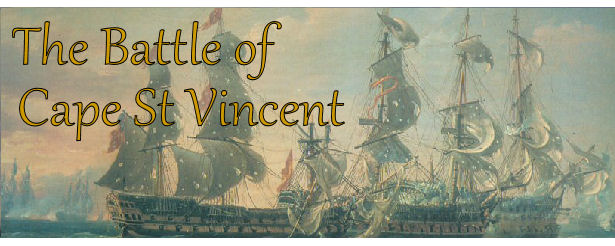
The Battle of Cape St Vincent was fought between the fleets of Britain and Spain on Valentine's Day 1797, and it was the battle in which Nelson made his mark and rose to become one of the most talked-about officers in the British navy.
|
Contents
Prologue - Commodore Nelson in the Mediterranaen (this page) The Morning of Battle |
Prologue: Commodore Nelson in the Mediterranean
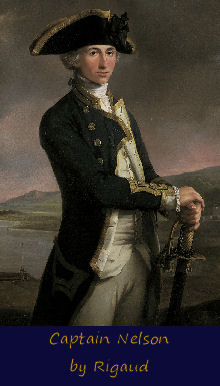 These events will be described in more detail on their own pages, but here is a
summary as background to the battle.
These events will be described in more detail on their own pages, but here is a
summary as background to the battle.
In 1793, Captain Nelson's long period of unemployment ashore in England was ended when he was given command of HMS Agamemnon, a 64-gun battleship, and sent to join Admiral Lord Hood's fleet in the Mediterranean. The Agamemnon would become his favourite ship, and he forever remained fond of her crew, many of whom followed him from ship to ship and who he called his 'old Agamemnons'.
In 1794, he took part in the capture of Corsica, Bastia and Calvi; in Calvi, he was hit in the face by gravel flung up by a shot on the ground, receiving an injury that left him blind in his right eye for the rest of his life. On the 13th March 1795, with Admiral Hotham's fleet, he fought in the Battle of the Gulf of Genoa, in which he attacked and helped to capture the Ça Ira, and in July he fought with the fleet at the Battle of Hyères Islands.
As a commodore, Nelson asked to be transferred to HMS Captain as the Agamemnon was badly in need of repairs and was sent home to be refit. He was granted his request, and in June 1796 was involved in the evacuation of Leghorn when the French invaded the town. In July, he was detached with a small squadron under his command to Italy, to help the Austrian army against the French. This involved blockading French ports and, with the help of Gilbert Elliot, the British viceroy in Corsica, taking possession of the neutral fort of Porto-Ferrajo on the island of Elba. This would prevent the French from using it to invade Corsica after taking Leghorn.
He did so well that he won the respect of Admiral John Jervis, who had become commander in chief of the Mediterranean fleet in the Autumn of 1795 - and he was not a man to give respect lightly. Soon, Nelson became one of Jervis' most trusted subordinates.
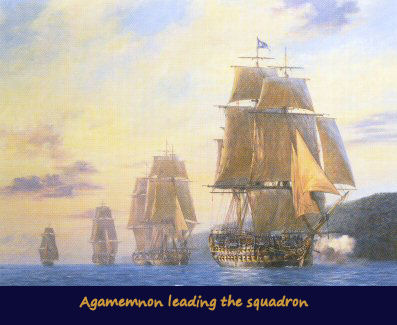 By August 1796, it was clear that Spain were about to enter the war on the side
of revolutionary France. The fleets of the two countries combined would
greatly outnumber the British, and so Admiral Jervis was ordered to retreat from
the Mediterranean. He had sent his second in command, Rear-Admiral Man,
with a squadron of seven ships, to get supplies from Gibraltar. After
receiving the evacuation order, Jervis sent orders for Man to meet him back at
Corsica as soon as possible.
By August 1796, it was clear that Spain were about to enter the war on the side
of revolutionary France. The fleets of the two countries combined would
greatly outnumber the British, and so Admiral Jervis was ordered to retreat from
the Mediterranean. He had sent his second in command, Rear-Admiral Man,
with a squadron of seven ships, to get supplies from Gibraltar. After
receiving the evacuation order, Jervis sent orders for Man to meet him back at
Corsica as soon as possible.
Meanwhile, in October, he sent Commodore Horatio Nelson to evacuate the British garrison at Bastia and take them to Porto-Ferrajo at Elba. While there, Nelson learnt that Corsica were negotiating with France and planning to seize British property and imprison Gilbert Elliot, the viceroy. Nelson was having none of that, and threatened to bombard the town. Unsurprisingly, they backed down.
On the 15th October, the Spanish fleet were seen off Cape Corse, and Jervis expected a major battle. But he was outnumbered, and had to wait for Man's squadron to return. But Man didn't show up, and on the 26th October the Spanish went into Toulon and joined the French fleet there, making a combined fleet of 34 ships of the line. Jervis had just 15.
Jervis was left with no choice but to leave the Mediterranean, so on the 2nd November he and his fleet sailed for Gibraltar. He still held out hope of seeing Man on the way, but rumours were begin to spread through the fleet that he had deserted.
In fact, Admiral Man had seen the Spanish fleet while at Gibraltar, and watched them sail eastwards into the Mediterranean. Knowing that the enemy were now between his small squadron and the main fleet, he turned tail and ran back to England. Having deprived the British fleet of seven valuable ships, Man was ordered by the Admiralty to strike his flag, and he never served again.
Jervis' fleet reached Gibraltar on the 1st December, and there he found orders to move his base to Lisbon. He sent Nelson, in a frigate called La Minerve and accompanied by another frigate, the Blanche, back to Elba, this time to rescue the garrison now stationed in Porto-Ferrajo, as the British fleet's evacuation of the Mediterranean would leave them stranded and at the mercy of the French. Jervis trusted Nelson enough to tell him to use his own judgement in his command, something which Nelson relished.
La Minerve and Blanche vs Santa Sabina and Ceres
So on the 10th December, Nelson left the Captain and joined La Minerve, whose captain was George Cockburn and, with the Blanche, set off for Elba.
On the 19th, at 10.20pm, Captain D'Arcy Preston in the Blanche saw two Spanish frigates, the Santa Sabina and the Ceres. Eager to leap into action, Nelson handled La Minerve himself (an unusual move for a flag officer, as this would normally be the Captain's job) and got to Santa Sabina's stern, close enough that he could hail the captain and ask him to surrender. The captain who, surprisingly, spoke very good English, refused with the remarkable reply,
"This is a Spanish frigate and you may begin as soon as you please."
So Nelson began, and the fight was vicious and close-run. In terms of men and guns, there wasn't much difference between the two frigates. They remained at such close-range that Nelson was able to hail the captain several more times, but each time received a refusal. Eventually, however, the Spanish were forced to surrender. As it turned out, the English-speaking captain of the Santa Sabina was Don Jacobo Stuart, a great grandson of the English king James II! Taking such a prestigious prisoner was something that Nelson was understandably very proud of. Meanwhile, the Blanche fought and took the Ceres.
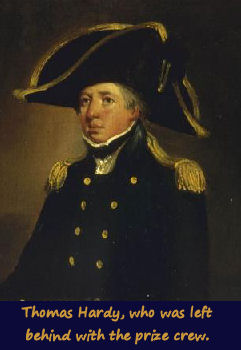 Nelson sent La Minerve's 1st Lieutenant John Culverhouse, along with
Lieutenant Thomas Hardy, with a boarding party to take possession of the
Santa Sabina after they had tied her to La Minerve with a tow rope.
However, another Spanish frigate suddenly appeared and opened fire on Santa
Sabina, while the two British lieutenants were on board. La Minerve
cast off the tow rope to free herself from the Santa Sabina and so be
able to fight the approaching enemy. But then another two Spanish ships of
the line, with two more frigates, appeared. La Minerve was badly
damaged and so Nelson and Cockburn were forced to abandon the prize entirely,
along with Culverhouse and Hardy, and the prize crew. But this did mean
that the prize crew aboard Santa Sabina were able to hoist English
colours and thus distract the Spanish ships, giving La Minerve a head
start so she was able to get away.
Nelson sent La Minerve's 1st Lieutenant John Culverhouse, along with
Lieutenant Thomas Hardy, with a boarding party to take possession of the
Santa Sabina after they had tied her to La Minerve with a tow rope.
However, another Spanish frigate suddenly appeared and opened fire on Santa
Sabina, while the two British lieutenants were on board. La Minerve
cast off the tow rope to free herself from the Santa Sabina and so be
able to fight the approaching enemy. But then another two Spanish ships of
the line, with two more frigates, appeared. La Minerve was badly
damaged and so Nelson and Cockburn were forced to abandon the prize entirely,
along with Culverhouse and Hardy, and the prize crew. But this did mean
that the prize crew aboard Santa Sabina were able to hoist English
colours and thus distract the Spanish ships, giving La Minerve a head
start so she was able to get away.
Much later, when the British prisoners had been taken to the Spanish town of Cartagena, Nelson exchanged Don Jacobo Stuart for Lieutenants Culverhouse and Hardy, and sent back all the Spanish prisoners from Elba in exchange for the rest of the British prize crew.
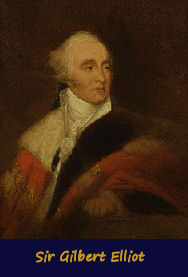 Nelson arrived at Elba expecting to begin an evacuation of the garrison, but the
British army officer General de Burgh had not had any orders to do so, so didn't
agree to it. Impatiently, Nelson sent Captain Thomas Fremantle in the
Inconstant to go and get the viceroy, Sir Gilbert Elliot, from Naples.
He arrived on the 22nd January 1797, but he also didn't agree to evacuate the
garrison. In the end, Nelson agreed to take Elliot on La Minerve to
Lisbon to speak with Admiral Jervis, and he did manage to take a convoy of naval
supplies from the island.
Nelson arrived at Elba expecting to begin an evacuation of the garrison, but the
British army officer General de Burgh had not had any orders to do so, so didn't
agree to it. Impatiently, Nelson sent Captain Thomas Fremantle in the
Inconstant to go and get the viceroy, Sir Gilbert Elliot, from Naples.
He arrived on the 22nd January 1797, but he also didn't agree to evacuate the
garrison. In the end, Nelson agreed to take Elliot on La Minerve to
Lisbon to speak with Admiral Jervis, and he did manage to take a convoy of naval
supplies from the island.
On the way back to Lisbon, Nelson had a scout about for the enemy fleet. He had a peek into Toulon, where they were last seen, but they weren't there. He continued along the coast to the Spanish port of Cartagena, but they weren't there either. He came to the conclusion that they must be heading for the Straits of Gibraltar.
Meanwhile, in October the Spanish fleet under commander Langara, had joined the French fleet, under Rear-Admiral Pierre Villeneuve (who would appear more than once in the Nelson story!), at Toulon. The combined fleets were then ordered to leave the Mediterranean and head north to help with the French invasion of Ireland.
So in December they made a move. Villeneuve was successful in dodging the British fleets, and got out of the Mediterranean and reached Brest, on the north-west coast of France - but, as it turned out, too late to help with the invasion, which failed.
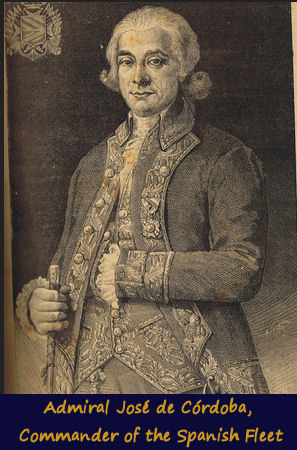 But Langara knew that the Spanish ships were in a poor state for a battle so
stopped off at Cartagena on 6th December for supplies and repairs. This
action led to him being replaced by an impatient Spanish government, but his
successor, Admiral José de Mazarredo, also refused to leave until the
problems with ships, supplies and under-manning were solved. He, too, was
therefore replaced, by Admiral José de Córdova y Ramos. The
problem was that Spain didn't dedicate anywhere near enough resources to their
navy in order to fight a successful war at sea. Technically, their ships
were some of the largest and finest in the world, but they were under-supplied
and their crews were not skilled or trained particularly well. For
example, the Santisima Trinidad was a beast of a ship - with four decks
and 130 guns, she was the largest ship in the world at that time. But only 60 out of her 900 crew had the experience and skill
needed to successfully man a ship of war.
But Langara knew that the Spanish ships were in a poor state for a battle so
stopped off at Cartagena on 6th December for supplies and repairs. This
action led to him being replaced by an impatient Spanish government, but his
successor, Admiral José de Mazarredo, also refused to leave until the
problems with ships, supplies and under-manning were solved. He, too, was
therefore replaced, by Admiral José de Córdova y Ramos. The
problem was that Spain didn't dedicate anywhere near enough resources to their
navy in order to fight a successful war at sea. Technically, their ships
were some of the largest and finest in the world, but they were under-supplied
and their crews were not skilled or trained particularly well. For
example, the Santisima Trinidad was a beast of a ship - with four decks
and 130 guns, she was the largest ship in the world at that time. But only 60 out of her 900 crew had the experience and skill
needed to successfully man a ship of war.
In 1793, while captain of the Agamemnon, Nelson had visited Cadiz and had a look round the dockyard. He wrote to his wife, Frances, concluding that "I am certain if our six barges' crews (which are picked men) had got on board one of their first rates they would have taken her. Therefore in vain may the Dons make fine ships, they cannot however make men."
This conclusion probably contributed to giving him the confidence that led to his remarkable actions in the forthcoming battle.
Having reached Gibraltar on the 1st December, Jervis' fleet was then caught in a violent storm. Two of his ships - the Courageux and Zealous - were wrecked. Another two - the Culloden and Gibraltar - ran aground. The Culloden was refloated but the Gibraltar was so badly damaged that she had to go back to England for extensive repairs. HMS Bombay Castle and the St George got stuck on a sandbank, and the latter had to go to Lisbon to repair. The British fleet had now been reduced to 10 ships.
As his ships were battered by the storm, Jervis watched the French fleet escape through the Straits and out into the Atlantic. He assumed that the Spanish were following and worried that they would intercept Nelson and his convoy, so headed to Cape St Vincent to wait for him.
On the 6th February 1797, Jervis was relieved to be reinforced by Rear-Admiral William Parker with his squadron of five ships, who also brought the news that the Irish invasion had failed and the French fleet were in Brest. This gave Jervis a little breathing space and he could now focus on the Spanish knowing that the French were out of the way.
All he had to do now was find them.
On the 1st of February, Córdova was ordered to take his 27 ships-of-the-line and 8 frigates to assist at the siege of Gibraltar. Crucially, he was also ordered to pick up a convoy from Malaga and take it to Cadiz. The convoy was made up of 5 'urcas', armed storeships carrying a valuable cargo of mercury.
On the 5th of February, Córdova detached 3 ships of the line, with launches, into Algeciras, and on the 6th the rest of the fleet reached Cadiz. But before the mercury ships could get into the port, a gale blew up which forced the whole fleet to stay out at sea for 8 days. This was Jervis' opportunity to find them.
On the 9th of February, he received a report from the frigate Viper that the Spanish had gone through the Straits on the 5th and gone into Cadiz on the 6th. But on the 10th, the Emerald reported that they were in fact still at sea.
"By God, I'll not lose Hardy!"
Also on the 9th, Nelson arrived at Gibraltar, having been unsuccessful in his search for the Spanish fleet. His passenger, Gilbert Elliot, went ashore to report to the governor, but Nelson was itching to get back out to sea. He turned down invitations to dine ashore, and even impatiently sent a note to Elliot's secretary asking for the party to be on board La Minerve by 8pm. He knew that a battle was imminent and didn't want to miss it. But one good thing to come out of the delay was that he was able to pick up Lieutenant's Culverhouse and Hardy after the exchange of prisoners.
Finally, Elliot finished his business ashore and boarded La Minerve. But just as she set off, two Spanish ships emerged from nearby Algeciras and gave chase. They began to close in, and as Nelson paced the quarterdeck with Colonel John Drinkwater, the Colonel asked him if an engagement was likely. Nelson replied that it was possible, then looked up at his broad pendant flying from the mast, and added,
"But before the Dons get hold of that bit of bunting I will have a struggle with them and sooner than give up the frigate I'll run her ashore."
But even as the Spanish frigates came close enough that Elliot began to prepare to throw his confidential papers overboard to stop them falling into enemy hands, a cry went up that a man had fallen overboard. The officers who had been entertaining Elliot and his party in the cabin rushed up on deck, and Hardy quickly lowered a boat over the side of the ship, manning it himself. But there was no sign of the man, so the crew of the boat started to row back to the ship.
The current was against them, and they made slow progress. The Spanish frigates were closing in, and it started to look as if poor Hardy would be captured again. It was a tense few moments, until Nelson could take it no longer and cried,
"By God, I'll not lose Hardy! Back the mizzen topsail."
So the ship slowed down enough that Hardy in his boat could catch up and get aboard. It seemed certain that the Spanish ship the Terrible would force them into a fight, but all of a sudden she shortened sail and dropped back. Nelson's slowing La Minerve had taken the Spanish commander by surprise, and he probably thought that Nelson had seen the British fleet and was luring him into a trap. Whatever the reason, it allowed Nelson to escape.
During the night, Nelson turned to the south to make sure he threw off his pursuers, but found himself in the middle of the Spanish fleet! Luckily, La Minerve managed to creep through undetected in the darkness, and in the morning went north towards Cadiz. Now he knew exactly where the enemy were, Nelson rushed to find Jervis and arrived on the 13th February. Culverhouse and Hardy, having been prisoners of the Spanish, also had valuable information about the fleet.
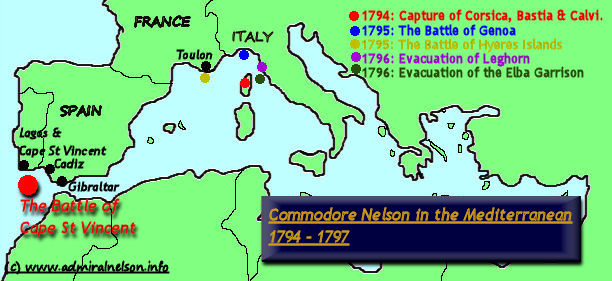
Two days before Nelson arrived back at the fleet, the convoy he'd sent from Elba got there. The Southampton reported seeing the Spanish fleet, and that they had been damaged in the storm. The Bonne Citoyenne brought yet another report, this time that the Spanish were 20 miles to the south-east, and heading for Cadiz. So by the time Nelson arrived, Jervis had the fleet preparing for battle and sailing towards where the enemy had been seen.
Nelson returned to the Captain, where he was greeted by Captain Ralph Miller, and also Captain Edward Berry, who hadn't been given a ship and so was on board as a volunteer. Gilbert Elliot transferred to the frigate Lively, and Jervis said that he could stay and watch the battle.
Copyright Vicki Singleton 2013.